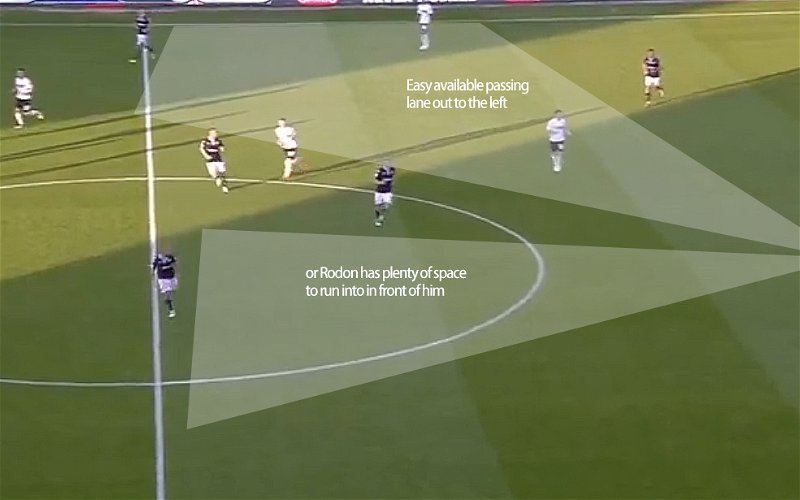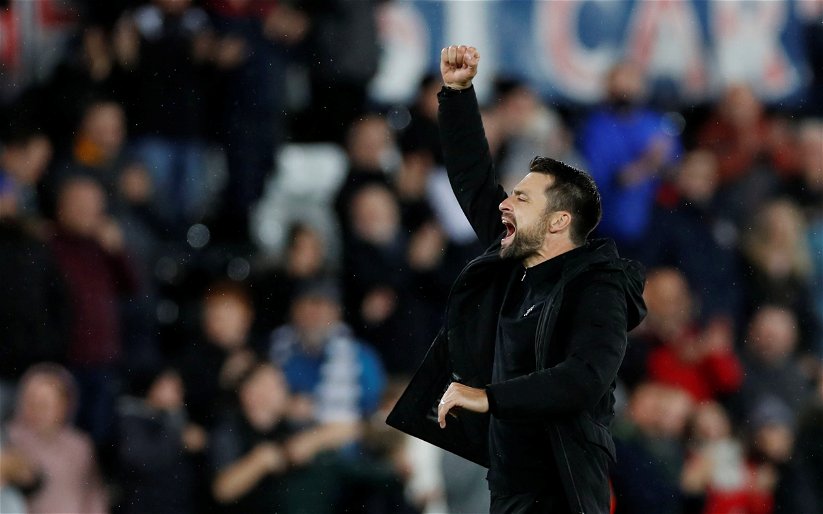We continue our match analysis feature of last weekend’s superb 2-1 late victory against Millwall at the Den, focusing on the second half and how Graham Potter’s side were able to take full advantage of Millwall’s poor shape.
How Swansea Continued to Stop Millwall
In the first half, Millwall showed a lack of attacking creativity and apart from one big chance that they had from a long diagonal pass, they had very little in terms of variety in their chances creation. As they did in the first 45 minutes, the home side continued to hit long diagonals for Morison to nod on.

As you’d expect from Potter, he was quick to work this out – Millwall’s main attacking route – and the Swans boss looked to make sure that they didn’t gain an advantage from it. With McBurnie still in a wide left position and helping Martin Olsson out in defence, the two both covered Morison as they aimed to win a greater number of aerial duels from these long diagonal passes. The two centre-backs don’t get involved here – as they shouldn’t – and Matt Grimes is also close by and well positioned to manage the knock-down – if Morison is still able to win the ball in the air against the pair.

The Swans also congested the wide areas which made it difficult for Millwall to play balls in behind Swansea’s defence as well as getting crosses into the box.

Below shows a typical example of how Millwall’s attacking shape let themselves down. In that huge open space, there’s only one player in support of the man in possession. There are four Swansea City players in the picture who can all help to manage the situation here and if they lose possession, there’s enough Swans players and plenty of space to quickly counter-attack.

Below, with no way through the middle as Swansea again have the area covered, Millwall’s Williams has to chip balls into wide positions.

Millwall’s Set Piece Goal
It was disappointing to see us concede and especially from a corner as it didn’t really look like they would carve out a clear opening as Graham Potter had made a few required adjustments to the limit the threat of the long diagonal.
van der Hoorn loses the aerial duel at the back post, and Millwall’s Wallace can run through into the shaded area to glance a header into the net. The Sky Sports’ commentators instantly referred to our zonal marking here as the culprit which always annoys me slightly. One thing I’ll give Paul Clement plenty of credit for is vastly improving us defending at set pieces. We went on a very long run of not conceding from set pieces and it was all down to his zonal marking system. Our zonal marking has looked pretty good this season for the most part, but it let itself down here at Millwall. Firstly, you’d expect van der Hoorn to win these aerials and the second balls are then always a danger afterwards. Would man-marking have helped? Not always, it depends on the quality of the marking and tracking.

Millwall’s continued lack of pressure and poor shape
While the Swans were well balanced and had a good structure in terms of their team shape, Millwall’s was all over the place throughout in comparison.
With a man advantage, they very rarely looked to take advantage of it and press our backline. They must have seen how much we struggled against that at Birmingham but they were too often more than happy to allow our defenders to have time and space on the ball at the back as the example below show.

Graham Potter hasn’t implemented a high and intense press but he’s instructed his players to be positioned effectively to block key passing lanes. Millwall however didn’t even do these basics and made it far too easy for us to bring the ball out from our defensive third.

Above shows how the space continues to be available as we make our way into the final third. Montero came on at the hour mark and Millwall didn’t adjust to limit his obvious threat down the left. Nobody gets tight on Montero above, and Matt Grimes also has space in support, while McBurnie can make a run through the middle.

Above shows how Millwall were still vulnerable to counter-attacks from the Swans given their lack of midfield presence and below is another example of Swansea’s ease to move the ball across their backline.

Swansea’s New Shape
Following the injuries to Fer and Olsson, Potter was forced into another sub on the hour mark as Montero replaced Olsson. That also forced Grimes to move from the centre of midfield to left back, with Celina now having to drop deeper alongside Carroll. Naughton moved into midfield and McBurnie was finally able to play in a more favourable attacking role through the middle.



Swansea City Equalise
Swansea City’s equaliser started off with a superb long-range pass from Tom Carroll in a deep position in midfield over to Jefferson Montero.

The winger wouldn’t really be able to get possession from a long ball like this really given his lack of height but he picks the ball up, turns his marker before squaring the ball across into the box.

Kyle Naughton picks up the ball, turns away from Shaun Williams and with his back to goal, he turns and arrows home a low shot into the left corner of the net.

Swansea City win it!
Swansea’s winner was thanks to some quick-thinking from Matt Grimes, who quickly plays a ball forward to Montero to race forward after an offside flag is raised.

It’s a fantastic attacking move, quick, first-time passes and what a pass back to Montero from Celina!
https://twitter.com/champgoals_/status/1036234490815893505
What’s also good to see so far this season is Montero dropping deeper in defensive support – not something we’re used to seeing from the winger.

The Swans had further chances after their 85th-minute winner as they broke forward again. This time it’s McBurnie who plays a pass inside for Carroll to run onto. Again, you can see Millwall’s poor defensive shape. As Carroll makes a run, McBurnie can also play the ball out wide to the opposite side.





